Nickel-based alloys are widely used in aviation, aerospace, chemical industry, and other fields due to their unique properties. Among them, Hastelloy X and Hastelloy C are two important nickel-based alloys, each showing excellent performance in specific fields. In this article, we will conduct a detailed comparative analysis of the difference between Hastelloy X and Hastelloy C in terms of materials, performance, application fields, etc.

What is the difference between Hastelloy X and Hastelloy C?
1. Material composition
Hastelloy X is a nickel-based high-temperature alloy with nickel, chromium, and molybdenum as its main components. Among them, the nickel content occupies the main body of the alloy, while chromium and molybdenum serve as solid solution strengthening elements, providing the alloy with excellent high-temperature strength and oxidation resistance. In addition, elements such as cobalt and tungsten are added to Hastelloy X to further enhance its high-temperature stability and corrosion resistance.
Hastelloy C, on the other hand, is a nickel-based alloy with added molybdenum and chromium. Compared to Hastelloy X, Hastelloy C has relatively lower nickel content but higher molybdenum and chromium content. This unique ingredient ratio gives Hastelloy C excellent corrosion resistance and oxidation resistance at high temperatures.
2. Performance characteristics
High temperature performance: Hastelloy X exhibits excellent oxidation resistance and corrosion resistance at high temperatures, and its operating temperature can reach 900°C or even higher. At the same time, the alloy also has good high-temperature strength and can withstand mechanical stress at high temperatures. In comparison, Hastelloy C also has excellent high temperature performance, but its operating temperature range is generally slightly lower than Hastelloy X.
Corrosion resistance: Hastelloy C performs well in highly corrosive media and can resist erosion by various strong acids such as sulfuric acid, hydrochloric acid, and nitric acid. This excellent corrosion resistance makes Hastelloy C have broad application prospects in chemical industry, petroleum and other fields. Although Hastelloy X also has good corrosion resistance, its performance in some specific media may be slightly inferior to Hastelloy C.
Mechanical properties: Both Hastelloy X and Hastelloy C have good mechanical properties, including tensile strength, yield strength, elongation, etc. However, due to differences in alloy composition, Hastelloy X has superior mechanical properties at high temperatures.
3. Application fields
Hastelloy X: Due to its excellent high temperature performance and corrosion resistance, Hastelloy X is widely used in high temperature and corrosive environments such as aerospace engines, gas turbines, and high temperature reactors. In addition, the alloy is also used to manufacture key components such as petrochemical equipment and nuclear reactors.
Hastelloy C: Hastelloy C is widely used in chemical, petroleum, electric power and other fields for its excellent corrosion resistance. For example, in processes such as sulfuric acid production, chloride treatment, and hydrochloric acid recovery, Hastelloy C can resist the erosion of highly corrosive media and ensure long-term stable operation of equipment.
Conclusion
To sum up, Hastelloy X and Hastelloy C, as two important nickel-based alloys, have significant differences in materials, properties and application fields.
Thank you for reading our article and we hope it can help you to have a better understanding of the difference between Hastelloy X and Hastelloy C. If you are looking for Hastelloy X and Hastelloy C suppliers and manufacturers online now, we would advise you to visit Huaxiao Alloy.
As a leading supplier of Hastelloy from Shanghai China, Huaxiao Alloy offers customers high-quality Hastelloy X and Hastelloy C at a very competitive price.



